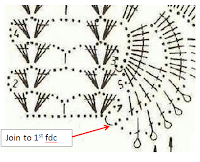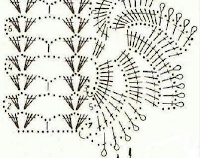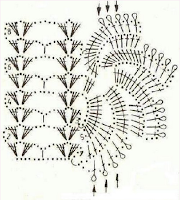General yarn information : You can use any yarn with a suitable hook to make this project.
As this is a delicate lacy project, I’d suggest using a lighter yarn.
Difficulty level : Intermediate to Advanced Skill level project.
The stitches used in this creation are basic, but they’ve been used so beautifully and creatively that one needs to have a little better understanding of playing with them. That said, there is a pretty good chart, and loads of helpful videos for how to work stitches.
I’ve tried to use that chart as much as possible to simplify the pattern.
Stitches used : Using U.S. terminology
Double Crochet : dc : yo, insert hk into st ; yo (3 lps on hk);
[yo, draw through 2 lps] twice. One dc made.
Chainless start for Double Crochet : I dislike the ch-2 / ch – 3 start, and this is what I do to start my row of dc.
Foundation double crochet (fdc) : This is a unique way of starting a project directly with a row of double crochet stitches. Here is an easy video tutorial https://youtu.be/hjNUYVvyU9k
How to work a picot stitch : Traditionally for a ch-3 picot, you work (ch 3, sl-st in 3rd ch from hook). For a ch-5 picot, you will do (ch 5, sl-st in 5th ch from hook).
Abbreviations used : (Using U.S terminology
lp(s) : Loop(s) sc : Single crochet
dc : Double crochet sp : Space
sl-st : Slip stitch ch : Chain
st(s) : Stitch(es) hk : Hook
yo : Yarn Over rep : repeat
fdc : Foundation Double Crochet
Instructions :
Please note that I start all my rows with a ch 1, turning chain for ease.
Please check the top of this blog for easy video tutorials on all stitches used in today's pattern.
Please read through all my notes before you pick up your hook, so you know just where we're heading in our pattern. This is a slightly complicated pattern and I’ve got loads of notes – bear with me.. they’re all useful!
We start with the a row of foundation double crochet and as we’re working the simple shelled pattern one one side of our scarf, we’re working on a really lovely intricate and lacy larger shelled pattern that will fall over the edge.
The beauty of this pattern is that we work the little complicated edging in while working the body of the scarf.
Now while working the edging, we will be working back and forth along the edging, AND going back and forth across the body of the scarf.
There is a lot of turning around and working back on the same row etc, so this becomes an Intermediate to Advanced skill level scarf only because of that.
I would also request that you follow with the chart so that it all becomes just a little simpler.
For all lacy scarves / wraps etc, I always like to use looser stitches, as they not only add to the laciness, but also block better.
In case of picots, I usually like to do a small swatch and deciding if I like the look of a ch-3 picot or a ch-5 picot with the yarn I’m using.
Even if the pattern says ch-3 and I think a ch-5 looks nicer, I’ll use a ch-5.
This pattern has a lot of picots.. and I’ve suggested you use a ch-3 picot.
Please decide for yourself depending on the yarn you’re using.
Right then, let’s forge ahead.
Start with 13 fdc ; ch 3 and Turn.
The last ch 3 is to take you up to the next row.
At the end of each row, we’ll have sts like this just before the “Turn” and they will not count as sts to be used in our pattern.
Row 1 : 3 dc in the 1st fdc ;
ch 3, 3 dc in the next fdc ;
ch 3, sk next 4 fdc, dc in the next fdc ;
3 dc in the next fdc ; ch 3, 3 dc in the last fdc ;
ch 4 and Turn.
Yet again, this last ch 4 before the “Turn” are not to be taken into consideration for pattern.
Row 2 : 3 dc in the 1st ch-3 sp ;
ch 3, 3 dc in the same ch-3 sp ;
ch 5, sk next 4 dc , 3 dc in the next ch-3 sp ;
ch 3, 3 dc in the same ch-3 sp ;
ch 3 and Turn.
Our shell pattern will now be the (3 dc , ch 3, 3 dc) ; all done in the ch-3 sps between the shells.
Row 3 : Shell in the 1st ch-3 sp ;
ch 3, dc in the next ch-5 sp ;
ch 3, shell in the next ch-3 sp ;
ch 4 and Turn.
Row 4 : Shell in the 1st ch-3 sp ;
ch 5, sk next 4 dc , shell in the next ch-3 sp ;
ch 4 and Turn.
We will start with the first row of our side pattern.
Our side pattern will be done over 10 side rows starting from this row.
For convenience and clarification, I will be naming our side rows just that.. Side Rows.
Now as we're going to work on side rows and main pattern rows, you 'may' want to add markers (for your convenience - naming the rows or color coding your markers) because we go back and forth with the rows.
You will probably need these for the first set, till you get the hang of what we're doing here.
Side Row 1 : ch 8 ;
sc into the top of the corner dc of Row 2. Turn.
We will work back on this ch 8 just made.
So let’s put our work down and look at the loveliness you’ve created.. and share a WIP on all the social network systems.. Instragram it and all that blah
So we’ve got our first furly, lacy pattern done.
We started with Row 4 and Side Row 1, so we needed to come back to this row. The side furl does look .. well, furly, curly.. but it does sit down flat and well after you’ve blocked it.
For our next side furl, we will need the last 3 picots made on Side Row 10.
We also need the 6th dc from that last set of dc you’ve just made on Side Row 10.
Please place markers if you so desire on these four points.
I will only refer to them as market picot(s) and marked dc for the next side row set.
We will join the side furl via the marked dc in the start of the next row (i.e Row 5) and the marked picots will be joined to the next furl via the next Side Row 1.
We will continue for the next four rows on the body of the scarf.
Row 5 : ch 2, Shell in the 1st ch-3 sp (of Row 4) ;
ch 3, dc in the next ch-5 sp ;
ch 3, shell in the next ch-3 sp ;
ch 4 and Turn.
Row 6 : Shell in the 1st ch-3 sp ;
ch 5, sk next 4 dc , 3 dc in the next ch-3 sp ;
ch 3, 3 dc in the same ch-3 sp ;
ch 3 and Turn.
Row 7 : Shell in the 1st ch-3 sp ;
ch 3, dc in the next ch-5 sp ;
ch 3, shell in the next ch-3 sp ;
ch 4 and Turn.
Row 8 : Shell in the 1st ch-3 sp ;
ch 5, sk next 4 dc , shell in the next ch-3 sp ;
ch 4 and Turn.
We’re going to make our Side furl once again at this point.
So while we will follow the same steps, all we’ll do is use the marked picots of the first set to join this new set on.
Side Row 1 : ch 8 ;
sc into the top of the corner dc of Row 6. Turn.
Remember that we will work back on this ch 8 just made again.
Side Row 2 : 12 dc in the ch-8 sp. Turn.
At the end of Side Row 3, we will attach this side row to the body of our scarf.
Side Row 3 : ch 7 ;
sk the 1st 6 dc , dc in the next dc ;
(ch 1, dc in the next dc) ;
rep (to) 4 times ;
ch 2, attach to the Row 4 corner st ; ch 2 and Turn.
In the following row, we make our picots and we join these picots onto the earlier set of marked picots.
So our picots for joining will be (ch 1, join to earlier picot with sc or sl-st, ch 1 and then sl-st into the 1st ch) for a ch-3 picot ;
And it will be (ch 2, join to earlier picot with sc or sl-st, ch 2 and then sl-st into the 1st ch) for a ch-5 picot
Side Row 4 : ch 4 ;
sk the 1st dc , [dc and picot-join in the next picot] ;
rep [to] 2 times ;
(ch 1, sk next dc , dc and picot in the next ch-1 sp) ;
rep (to) once ;
ch 1, dc in the next dc ;
11 dc in the next ch-7 sp. Turn.
The rest of this pattern is the same as before.
Side Row 5 : ch 7 ;
sk the 1st 5 dc , dc in the next 6 dc. Turn.
Side Row 6 : ch 3 ;
sk the 1st dc , dc and picot in the next ch-1 sp ;
(ch 1, sk next dc , dc and picot in the next ch-1 sp) ;
rep (to) 3 times ;
ch 1, dc in the next dc ;
11 dc in the next ch-7 sp. Turn.
Side Row 7 : ch 7 ;
sk the next 1st 5 dc , dc in the next dc ;
(ch 1, dc in the next dc) ;
rep (to) 4 times. Turn.
Side Row 8 : ch 3 ;
sk the 1st dc , dc and picot in the next ch-1 sp ;
(ch 1, sk next dc , dc and picot in the next ch-1 sp) ;
rep (to) 3 times ;
ch 1, dc in the next dc ;
12 dc in the next ch-7 sp. Turn.
Side Row 9 : ch 7 ;
sk the next 1st 5 dc , dc in the next dc ;
(ch 1, dc in the next dc) ;
rep (to) 4 times. Turn.
Side Row 10 : ch 3 ;
sk the 1st dc , dc and picot in the next ch-1 sp ;
(ch 1, sk next dc , dc and picot in the next ch-1 sp) ;
rep (to) 3 times ;
ch 1, dc in the next dc ;
11 dc in the next ch-7 sp ;
3 dc in the 1st ch-8 sp from Side Row 1. Turn.
And that completes one pattern repeat.
Our pattern repeat is from Row 5 to Side Row 10
Continue these repeats till your project is as long as you desire.
My tweak
I wanted a stole-like / wrap-like creation, so after my project was the length I wanted, I started on another similar stole, and then joined the shell stitches to one another – so that I now had 4 shelled stitches per row and the furly curly lacy edges on both sides of my work.
Here are some easy videos for joining your work.
Invisible join : Here’s a quick tutorial on how to join using the embroidery needle and whipstitch to get an invisible join at https://youtu.be/a6XZQ6VzJFM
















No comments:
Post a Comment
Thanks for taking the time to stop by. Do tell me what you think. Cheers